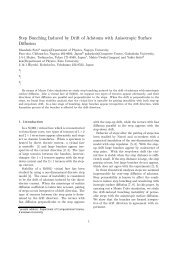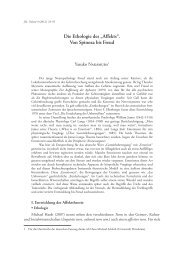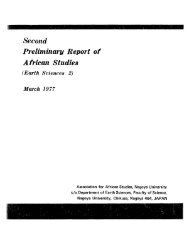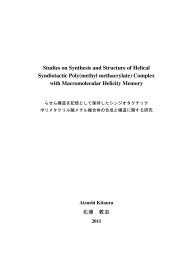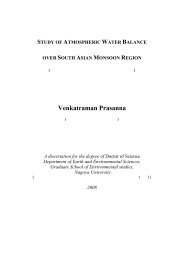k9254.pdf
k9254.pdf
k9254.pdf
You also want an ePaper? Increase the reach of your titles
YUMPU automatically turns print PDFs into web optimized ePapers that Google loves.
homogeneous wetting, liquid completely penetrates into the roughness grooves, whereas air is<br />
trapped underneath the liquid, inside the rough groves at heterogeneous wetting. The transition<br />
between these regimes plays an important role in the hydrophilicity and hydrophobicity 13 .<br />
It is well known that many polymer brushes on solid surfaces composed by different monomer<br />
undergo a volume phase transition from hydrophobic state to hydrophilic state in response to<br />
infinitesimal changes in temperature, pH, solvent composition, and hydrostatic pressure 14-18 . The<br />
volume phase transition is very important because of its technological importance for<br />
applications to actuators and drug delivery system 19 . Up to now, many investigations have been<br />
carried out to examine the phase transition of PNIPA as a function of temperature, pH or<br />
hydrostatic pressure 20-22 . But the phase transition of polymer brash, considering the hydrophilic<br />
and hydrophobic properties, no systematic study about the mechanism or reason has been<br />
reported.<br />
This paper deals with synthesized high-density polymer brushes of PNIPA on silicon surface by<br />
the ―grafting from‖ method and measured the static contact angle of sessile air bubbles in water<br />
on PNIPA grafted membrane surfaces. Here we observed that PNIPA membrane showed an<br />
unexpected phase transition behavior at temperature near LCST. To clarify this surprising<br />
behavior, we converted the terminal Chlorine group of the PNIPA brush chain by less<br />
electronegative Azide group and checked the wettability. Then we also converted the<br />
electronegative Azide to more hydrophobic carboxyl acid group and studied the effect of<br />
terminal end molecule on the wettability of the PNIPA brush surfaces. We also checked the<br />
phase transition of PNIPA grafted membranes under different pH solutions.<br />
3.2. Experimental section.<br />
3.2.1. Materials.<br />
Tetrahydrofuran (THF) (Kishida Chemical Co, Ltd.) and di-methylformaldehyde (DMF)<br />
(Kishida Chemical Co, Ltd.) were distilled from calcium hydride. Sodium Azide (NaN3) (99.9%)<br />
(Sigma Aldrich) and 4-ethanoic benzoic acid (99.5%) (AB Chem. Inc.) were used as received.<br />
Deuterated solvents, dimethylsulfoxide-d6 (d-DMSO) and deuterium oxide (D2O), for<br />
46<br />
1 H NMR



